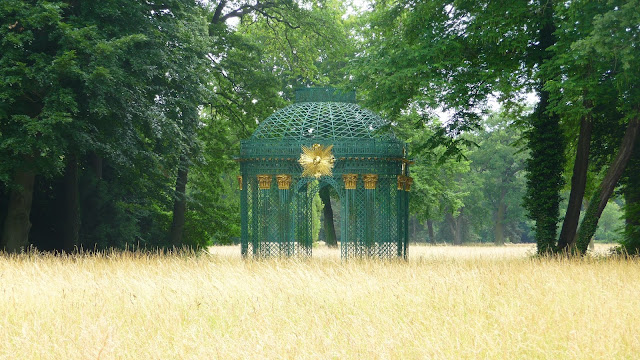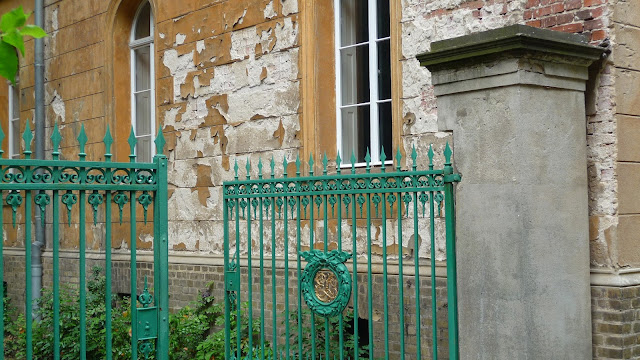The last time I came to Germany five years ago, my mother, who is not a big fan of long-distance plane travel, elected not to come along with my dad to visit me. But I made her promise that if I went back to Germany that she would visit me then. And she kept her word, of course. About a week before I had to pack up my things and make the move from Berlin to London, my parents flew out for a visit. I took them crisscrossing over Berlin to all of my favourite sites. Since I've spoken about most them before, it doesn't bear repeating here--I'll let the photos do the talking:
 |
| Checkpoint Charlie. |
 |
| Weißensee in the rain. |
 |
| And again. |
 |
| And again, in a brief moment of sunshine. |
 |
| We went on a quest through the huge cemetery looking for this memorial and grave site containing the ashes of 279 victims killed in German concentration camps, placed there by the Berlin Jewish community during the Third Reich--back when the Nazis would still send the ashes of victims home to relatives, for a fee. |
 |
| East Side Gallery (on Canada Day--hence my Canuck T-shirt!) |
 |
| The Jewish Museum. I went again, in search of the Jew in the Box, who once again was not there. Damn it. |
 |
| Garden of Exile, in the Jewish Museum. |
 |
| Glassed-in courtyard of the Jewish Museum |
 |
| A quotation from Primo Levi, marking the entrance of the small, yet powerful, Holocaust museum underneath the Memorial to the Murdered Jews of Europe in central Berlin. |
 |
| The memorial, with the Reichstag and side of the Brandenburg gate in the background. |
 |
| Brandenburger Tor! |
 |
| Corner of the beautiful Deutsches Historisches Museum on a perfect, 23-degree day in Berlin. |
 |
| The plaque at the book-burning memorial in Babelplatz, by Humboldt University--a haunting, eerily prescient quotation (from 1820!) by the poet Heinrich Heine, which roughly translates to: "Where they have burned books, they will end in burning human beings." |
 |
| The beautiful Berliner Dom. |
 |
| Museum Island colonnade. |
 |
| Bullet-scarred building in the old Jewish quarter. |
 |
| Security at the Jewish high school. |
 |
| Memorial to Berlin's Jewish children. |
 |
| By the memorial. |
 |
| Old guard tower by the Berlin Wall memorial. |
 |
| Fields of rye growing by the Berlin Wall memorial. |
 |
| A church used to stand in the no-man's land between the Wall. The GDR eventually had the church demolished to make room for the death strip. Here's where the church spire toppled. |
 |
| Reichstag dome. |
There were a couple of things I did with my parents that I haven't talked about on this blog yet, so I'll elaborate a little bit more on them.
We went to Hohenschoenhausen Prison, the Stasi's (East German secret police) main prison in Berlin, today a haunting museum and memorial. You can only visit the site through a guided tour. Many of the guides are former inmates of the prison, people who were picked up by the Stasi and interrogated and tortured here for anywhere from a few days or several months. Our guide was not one of these former inmates, but rather a Dutch transplant who, appropriately, teaches history in Berlin. He led us through parts of the prison complex, including the infamous "Submarine," a series of cell-lined hallways in the damp, cold basement of one of the buildings. The building was quite old and not watertight--being in the basement, many of the cells constantly had an inch or two of water on the floors, and that doesn't include some of the specially designed cells where particularly reticent prisoners would be immersed sometimes up to their chests in icy cold water for indefinite periods of time.
Basically, it was a nasty, spooky place.
The entire area surrounding Hohenschoenhausen Prison was a restricted Stasi zone. All of the neighbouring buildings were State Security offices and warehouses--one building housed a factory where the bugs the Stasi used to spy on suspected subversives were manufactured. It's worth also saying a word about how the prisoners would be brought to Hohenschoenhausen. Part of the reason for the restricted zone surrounding the prison was so no one would know about the whereabouts of the prison. The Stasi would arrest people without warning and transport them to Hohenschoenhausen, located in the far eastern reaches of Berlin, in a cell hidden within the back of an innocuous looking flower (or sometimes fish or milk) delivery van. The prisoner would be blindfolded and chained, and the driver would take a dizzying route to the prison. Sometimes, our guide informed us, they would drive more than an hour throughout the city or into surrounding countryside before arriving at the prison, just to be sure that the prisoners could have no idea where they were. Upon arrival, the van would drive straight into a garage, so that the prisoners would never even see the outdoor area of the prison complex. Cell windows, where they were any, were blurred and impossible to see through.
Our visit to Hohenschoenhausen offered a fascinating glimpse into the frightening world of the Stasi. The fact that this prison was still in operation within my lifetime sits quite heavily with me.
If you're ever in Berlin, you must go to Hohenschoenhausen. They offer English-language tours once daily, for a very minimal entrance fee. Do it.
 |
| A creepy interrogation room. Anyone seen The Lives of Others? It was not filmed at Hohenschoenhausen, although much of the film was set there--apparently there were, unsurprisingly, historical inaccuracies with the script and the director of the Hohenschoenhausen memorial refused to grant permission to film on the site. But anyway, what you don't see in this photo is the stool in the corner that the prisoner would be made to sit on, which was, as in the movie, covered with a piece of fabric, and, as in the movie, the prisoners would be made to sit with their hands underneath their legs, and their sweat would be collected in these pieces of fabric and stored as scent samples in the event of a prisoner's escape. |
On a decidedly more upbeat and genteel note, my parents and I travelled the next day to Potsdam to visit the Prussian royal family's collection of rich summer palaces. Potsdam is less than an hour's train ride southwest of Berlin, and you can get there quite easily on the S-Bahn. Of course, the S-Bahn wasn't running all the way to Potsdam on the Sunday morning we decided to go, but fortunately Germany is nothing but well-covered by trains, and you can use the same ticket on any of the regional trains, as well. To make a long story short, we got there after some minor delays. We got off at the wrong station in Potsdam, however, and after a few wrong terms and a failed conversation to get directions with a passerby, I managed to tap into my memory from five years ago and find our way to Sanssouci Park, where the palaces are.
I had been to Potsdam on my previous trip to Berlin with the great people I had met in the program back then. That day trip to Potsdam stands clearly out in my mind as one of the best days I've ever had--everything was perfect from the weather to the company to the majesty of a giant, manicured garden complete with a handful of lovely, ornate palaces. This time around, the company was good and the grounds just as lovely as I remembered, but unfortunately it was quite chilly and made for some brisk walks through the park.
At any rate, here are some shots of the beautiful grounds at Sanssouci Park and the neighbouring cutesy, touristy town of Potsdam:

On our way back to Berlin from Potsdam, we got off the S-Bahn at Grunewald station, located on the outskirts of Berlin, to visit one of my favourite (that's a strange word to use here, but so it is) Holocaust memorials.
Platform 17 at Grunewald station, still very much a small, working train station, was the location from which the Nazis deported most of Berlin's Jewish citizens to the death camps in the East. The Deutsche Bahn (German railroad company) put up the memorial to acknowledge the role the company played in providing trains for the deportations. The track leads to nowhere today, and has been allowed to become overgrown with trees and bush. On the edges of the platform, you can find the basic known information about each transport that left from that location during the war.
 |
| Roughly translated as "to remember the train deportations to the death camps by the Deutsche Bahn from 1941 to 1945." |
 |
| The platform. |
 |
| Two large deportations in early 1942 to Latvia and Poland. |
 |
| By 1943, most transports were going directly to Auschwitz. |
 |
| End of the line. |
 |
| Roughly translated as: "To remember the tens of thousands of Jewish citizens of Berlin who, from October 1941 to February 1945, were deported by the Nazis from this spot to the death camps, and were murdered there." |
So, that's about all of the Berlin portion of my parents' visit! My next post will be about some of my reflections on Germany, and then I plan to write about phase two of my parents' visit--London!
For now, I leave you with this:
 |
| In Tegel airport, waiting for our plane to London. Sad to be leaving Berlin... |
 |
| ...but, excited about England! |
Oh, and this:
 |
| All of the Birkenstocks that I sent home with my parents! Only two of the boxes are mine--the others are gifts! |
Annndd this:
 |
| Last one, the day before leaving. It ruined my dinner, but to hell with it. |
FINAL BREZELN COUNT: 21
(All told, that works out to about two pretzels a week, on average. I think I demonstrated some restraint!)



































































No comments:
Post a Comment